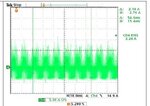techieguy
Newbie level 2
Hello guys,
I'm looking for some help a couple days. I have the waveform attached, this is the ripple current (ac current) through a electrolytic cap. This cap in located on the output of a power factor correction circuit at the input stage (after the full wave rectifier bridge). There is a component frequency of 120Hz and switching noise of the PWM. The question is when choosing the cap, do I have to use frequency multiplier different that 1 to calculate the maximum ripple current?
Thank you for helping me.
Techie.

I'm looking for some help a couple days. I have the waveform attached, this is the ripple current (ac current) through a electrolytic cap. This cap in located on the output of a power factor correction circuit at the input stage (after the full wave rectifier bridge). There is a component frequency of 120Hz and switching noise of the PWM. The question is when choosing the cap, do I have to use frequency multiplier different that 1 to calculate the maximum ripple current?
Thank you for helping me.
Techie.
